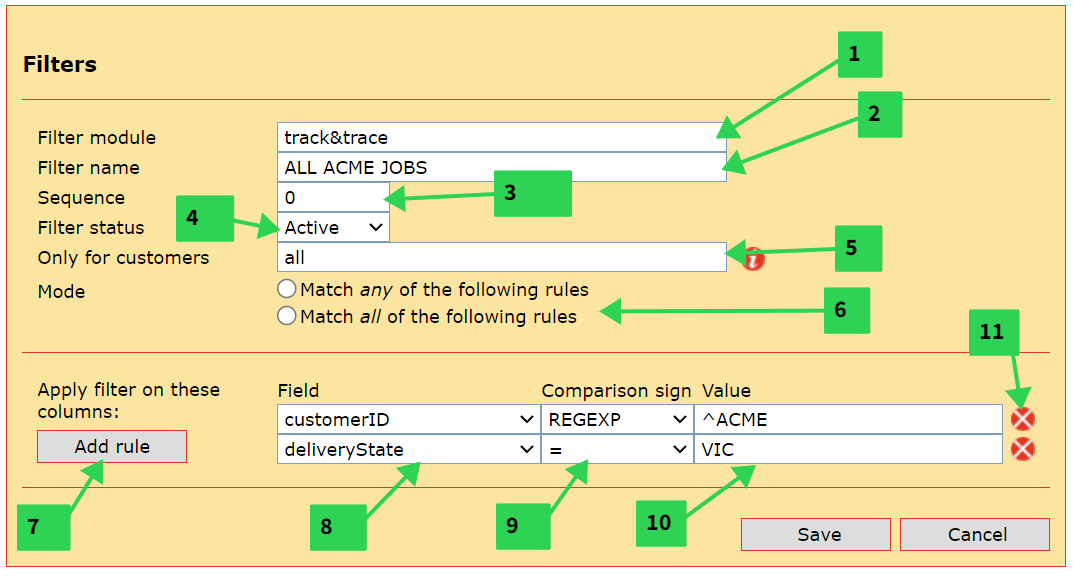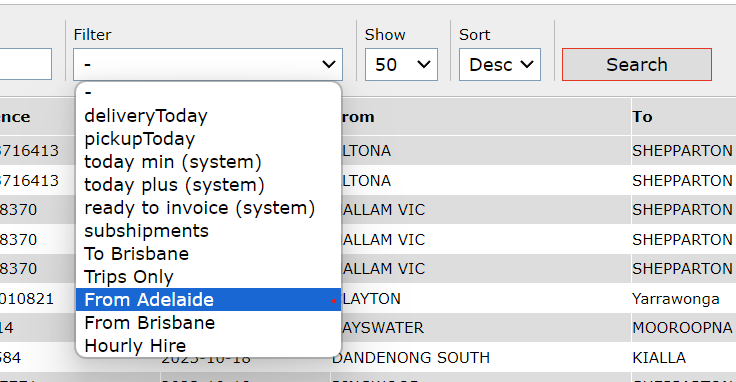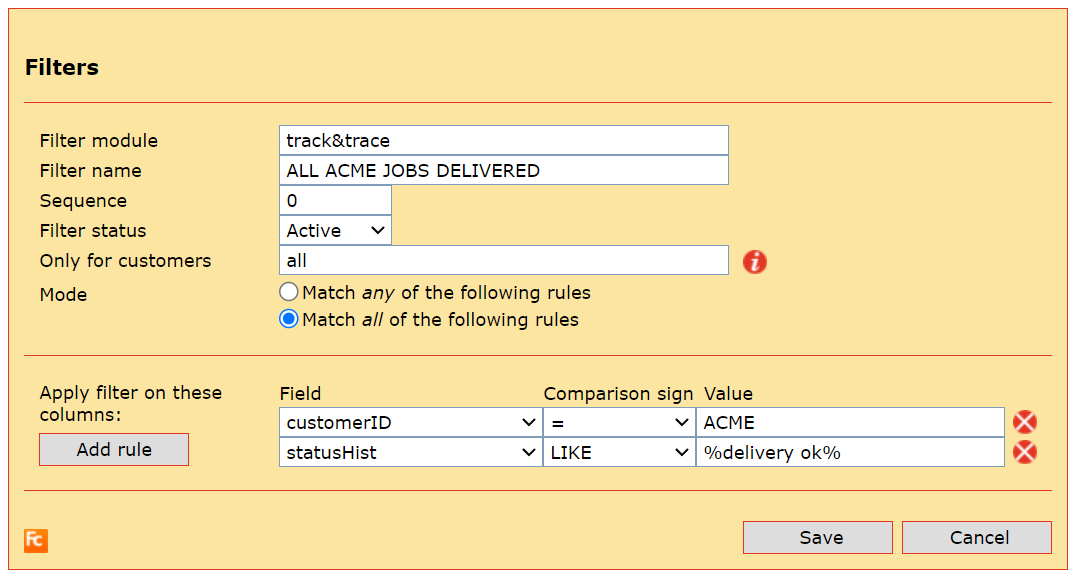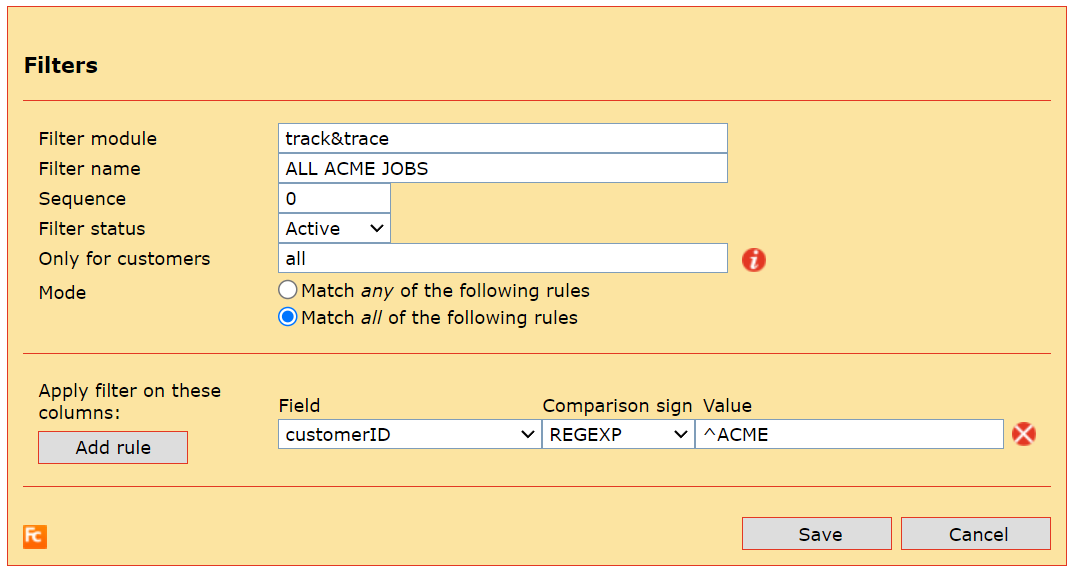Core concepts
Filters
Create, edit and manage filters for use when sorting shipments and reports.
Updated 1 week ago
Contents
Editing and creating filters.
Filter creation and modification can be very technical depending on your business needs, they are most commonly created and maintained by CombineIT support.
Filters are typically found under Settings -> Filters and may be configured to require company admin (level 70) user access to edit. If you are unable to edit or manage your filters please contact customer support for assistance.
Filter edit screen

Filter module: The "system" used to define where the filter is applicable. Default is "track&trace"
Possible values:
track&trace
dispatch
whproduct
whlocation
quotation
batch
Filter name: This is the text displayed in the dropdown when selecting filters.
Sequence: This defines how filters are ordered in a list.
Filter status: Toggles a filter between active and inactive, an inactive filter will not appear in the list of filters but will not be deleted.
Only for customers: Per filter you can decide for which customer this filter is displayed. Default: "all"
Note: if you want to display this filter for multiple customers, use comma [,] as a separator. Do not use blank space in between.
If you want to display this filter for all customers, make it blank or fill in: all (lowercase).
Mode: A filter may have one or many rules/conditions, this defines how those rules are applied.
"Match any of the following rules" means an "OR" comparison, if any of the rules are true, then the item will be included.
"Match all of the following rules" mans an "AND" comparison, if ALL of the rules are true, then this item will be included.
A combination of AND and OR comparisons is possible with advanced regex rules or advanced field settings, see "Advanced examples" below.
Add rule: Clicking this button will add another rule input.
Field: Available fields to build your rule from
Field values in this dropdown can be updated by modifying applicable parameters "orderFieldNames" and "shipFieldNames" - please edit these with caution.
Comparison sign: How the rule is evaluated to be true. Available options are:
"=" TRUE if the field equals the value
"!=" TRUE if the field does not equal the value
">" TRUE if the field is greater than the value
">=" TRUE if the field is greater than or equals to the value
"<" TRUE if the field is less than the value
"<=" TRUE if the field is less than or equals to the value
"LIKE" TRUE if the field matches a MYSQL-type LIKE condition using value.
"NOT LIKE" TRUE if the field DOES NOT match a MYSQL-type LIKE condition using value.
"REGEXP" TRUE if the field returns a match for the REGEX expression in the value input.
"NOT REGEXP" TRUE if the field DOES NOT return a match for the REGEX expression in the value input.
"IN" TRUE if the field value is contained in a MYSQL-type IN condition value.
Value: The value of the rule.
Delete this rule.
Using filters
Filters are commonly used
From the active shipments screen
From the planning board
As rules for scheduled reports

When a filter is selected, it will be applied and only matching results will be returned. A filter can be combined with other search criteria.
Examples
All shipments belonging to a specific customer
All jobs with the customer ID is exactly "ACME" will be returned.

All shipments belonging to a specific customer and the shipment has had the "delivery ok" status
All jobs with the customer ID is exactly "ACME" AND the status history contains the text "delivery ok"

Advanced examples
All shipments where the customer starts with a value
Using regex, all jobs with the customer ID STARTS WITH "ACME" will be returned. e.g. "ACMEVIC" and "ACMENSW" would both match

Combined AND and OR conditions using custom fields.
By creating custom fields with a double pipe character "||" between two fields, we can combine the "Match all of the following rules" with an OR condition"
This example's logic is: If the pickup state or the delivery state is equal to VIC and the customer ID is ACME
Or as an equation: ((pickupState = VIC OR deliveryState = VIC) AND customerID = ACME)


